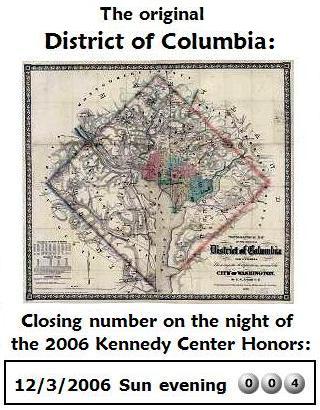vs. Christ Church
“… the closing number
for Spielberg’s tribute
and the gala itself…
[is] the finale to
the opera ‘Candide,’
‘Make Our Garden Grow.'” on this year’s
Kennedy Center Honors
Wallace Stevens,
“Esthétique du Mal, XI”—
“We are not
At the centre of a diamond.”

The map shows the original
(pre-1846) diamond shape
of the District of Columbia.
For the relevance of the
closing number of “Candide”
to diamonds, see
the previous entry.
For the relevance of the
closing number of the
12/3/06 DC lottery, see
Theme and Variations.
For the relevance of the
earlier mid-day number,
see the conclusion of
“Esthétique du Mal” —
| “And out of what one sees and hears and out Of what one feels, who could have thought to make So many selves, so many sensuous worlds, As if the air, the mid-day air, was swarming With the metaphysical changes that occur, Merely in living as and where we live.” |

A search on the mid-day number
in the context of metaphysics
yields the following:
Related material:
— Conversations with the Dead:
The Ontological Substructure of
Wallace Stevens’s “Esthétique du Mal“—
a 1999 Master’s thesis
For further remarks on
ontological substructure,
see A First Class Degree
(on a notable graduate of
Christ Church, Oxford).
